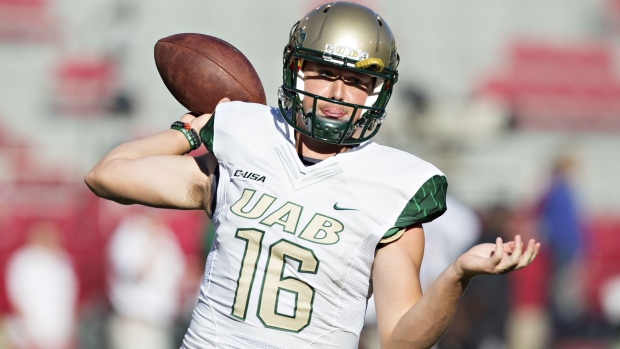Jun 1, 2015
UAB bringing football program back
UAB President Ray Watts is bringing the football program back. Watts told The Associated Press that he decided on Monday morning to reverse the earlier decision after meetings with UAB supporters continued through the weekend.
TSN.ca Staff

BIRMINGHAM, Ala. -- UAB President Ray Watts said Monday he is bringing the football program back in 2016, reversing a decision to shut it down because it was too expensive. Watts cited renewed financial commitment from supporters, students and the city as reasons for the change of heart.
He said donors have pledged to make up the projected $17.2 million deficit over the next five years if football is restored. Watts told The Associated Press he decided on Monday morning to reverse the earlier decision after meetings with UAB supporters continued through the weekend.
"Our students, our alumni, the city of Birmingham and now many community members have stepped up with commitments to cover that $17.2 million operational deficit," Watts said. "That's why we're in a position today to make this decision."
Watts was scheduled to announce the decision to reinstate football, along with bowling and rifle, later Monday. He cut the programs last December after UAB commissioned a report saying it would cost $49 million over five years to field a competitive program, generating both a groundswell of criticism for the decision and a rallying of financial support for the Blazers program.
The president said UAB has dropped an indoor practice facility from the equation since the initial report, and has raised about 10 per cent of the estimated $12.5 million- $14.5 million needed for a turf practice field and new fieldhouse.
UAB commissioned College Sports Solutions to review the initial report by CarrSports Consulting. The numbers were similar minus the indoor facility. Watts also said UAB's cost of attendance could be about half the initial projected $5,000 per athlete, based on other Conference USA schools. The first season's College Football Playoff payout also was higher than UAB had projected.
Watts said that the initial projections "showed there was no way for us to cover that unless we took away from education and research and health care."
Watts said he is sending documents to C-USA and NCAA notifying them of his decision.
Without football, UAB would have likely not have remained in C-USA, which has a bylaw requiring members to field football programs.
C-USA Commissioner Britton Bankowski said members had not wanted to change the rule because "football is something that is critical to our long-term success and part of our core as a conference."
"It didn't really come as a great surprise, but we're very pleased with the decision to bring back football," Bankowski told AP. "As a conference, we're committed to football so we welcome the good news that UAB football has been given another chance."
UAB will cap its subsidizing of athletics to $14.49 million for each of the next five years, about $200,000 less than the university paid in 2014.
The City of Birmingham and UAB's National Alumni Society have each pledged contributions to athletics while student government leaders will raise student fees. Those total $5.3 million with the balance of money coming from private donors.
One thing that's not on the table: UAB building an on-campus stadium to replace aging Legion Field. Watts said that's up to the city and community to fund.
"We believe that a stadium is best addressed by the city and our communities here and by our community leaders," Watts said, citing a new baseball field that houses Birmingham's Class AA franchise.
"We will be happy to play in any new, modern facility that the city might choose to build. We leave the specific type of facility and the exact location up to the mayor and city leaders and community leaders."
Now comes a huge rebuilding process on the field.
Many of the players have moved onto other programs, leaving Clark and his staff to find recruits for 2016. Newly hired athletic director Mark Ingram said bringing football back "will bring a lot of renewed excitement around this program, that's from top to bottom."
He said getting down to the details of fielding a team is next on the agenda.
"No question that's a challenge," Ingram said, with Watts noting, "And an opportunity."




